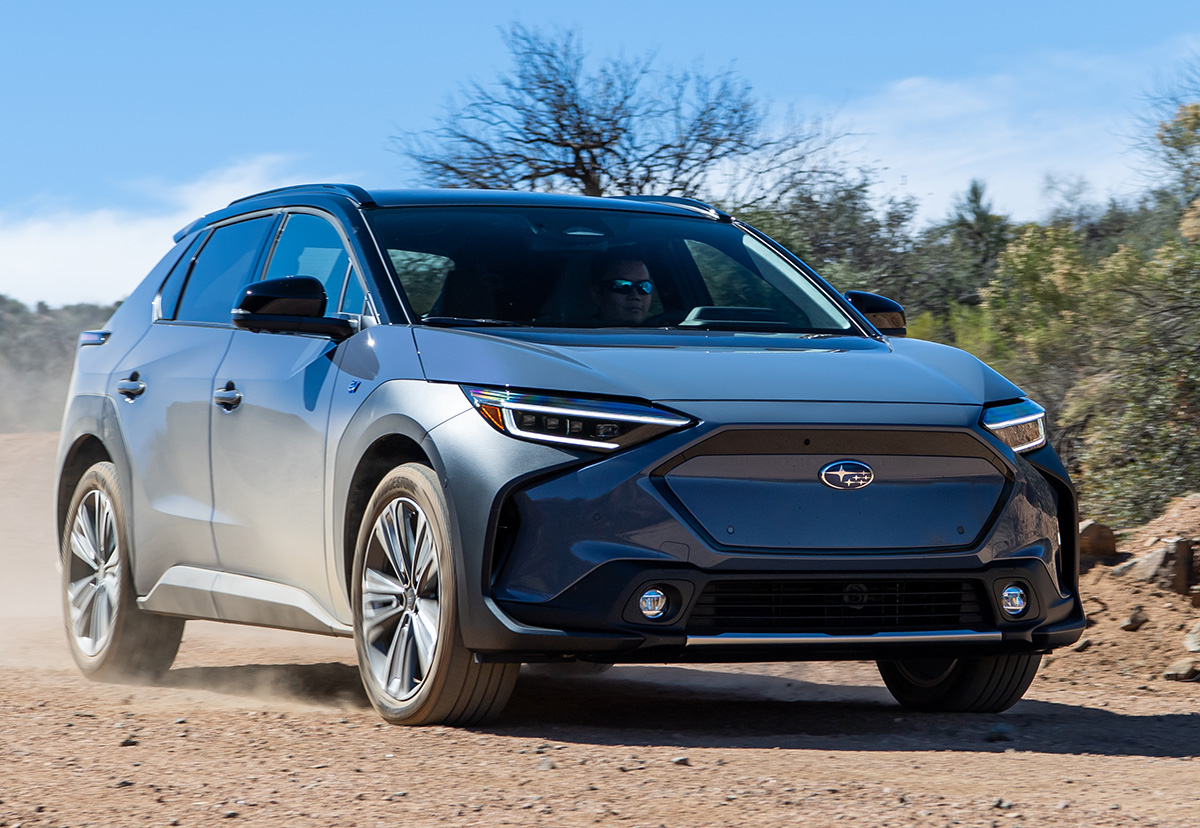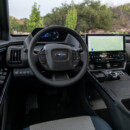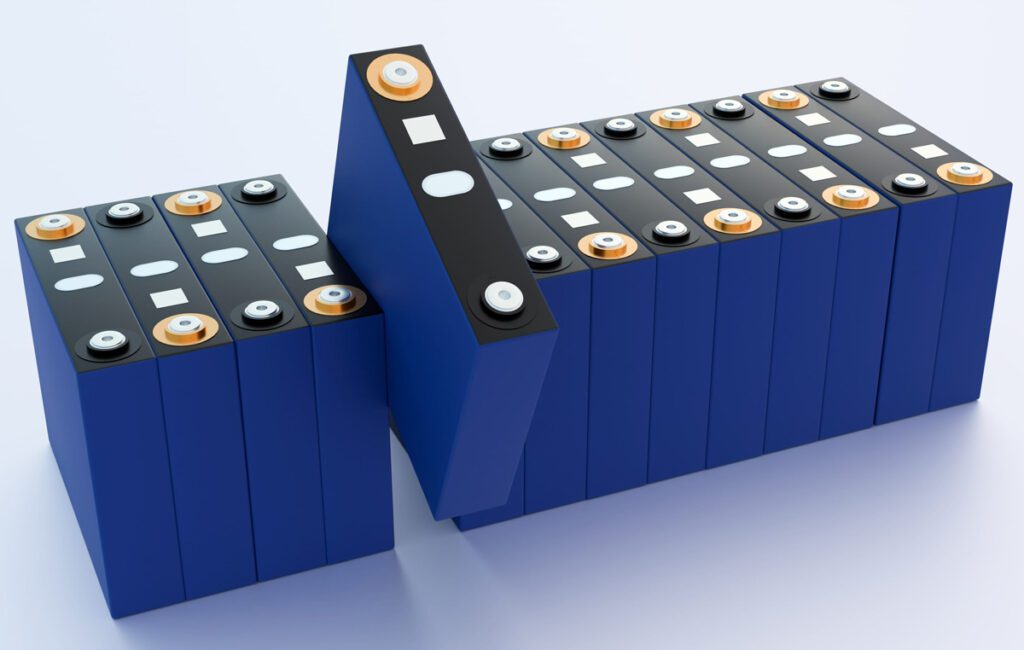Subaru’s outdoorsy buyers can now travel to their adventures in a zero-emission SUV with the company’s usual all-wheel drive.
The new 2023 Subaru Solterra crossover utility vehicle is the first all-electric vehicle from the small Japanese maker known for its rugged, affordable, all-wheel-drive vehicles; adventurous owners; and ads featuring Golden and Labrador Retrievers.
For a brand whose owners are so outdoorsy and eco-conscious, you may have expected Subaru to launch an EV long before now. But by global standards, the company is tiny—at roughly 1 million sales a year, one-tenth the number of VW Group—and it simply doesn’t have the financial resources to develop EV technology in-house.
That meant it depends on the huge global automaker that owns 20 percent of Subaru for electric-car batteries and components. That would be Toyota, also 10 times its size—and, historically, the global industry’s largest EV laggard and naysayer. That’s why Subaru is launching its first EV more than a decade after Japanese pioneer Nissan.

The delay ensured, however, that the Solterra emerged as a utility vehicle rather than a passenger car. That aligns neatly with the bulk of the brand’s well-regarded SUV lineup. The new electric Subaru has an adequate, if far from class-leading, range rated by the EPA at 228 miles for the base Premium model, and 222 miles for higher-level trims.
Subaru did it, as insiders know, by rebadging a vehicle that will simultaneously be sold as the 2023 Toyota bZ4X. The two models share underpinnings, the majority of their sheet metal, and most of their interiors. The Solterra is distinguished by standard all-wheel drive, Subaru-specific tuning for its all-wheel drive system, a hallmark of the brand for decades, a unique front end design, and some minor trim differences.
Reporters won’t have drive impressions for the Toyota for a few more weeks, however. So Subaru gets first crack at the publicity and resulting interest among car shoppers, who may be more favorably disposed toward EVs given soaring gas prices during the first half of 2022. For what it’s worth, the company also has by far the better model name: ‘Solterra’ combines the Latin words for sun and earth. It’s alliterative, and far easier to remember than a jumbled string of oddly capitalized letters with a number in the middle.
Behind the wheel
Getting behind the wheel of a new Solterra, a driver’s first impression may be the good front visibility due to a low cowl and slim pillars. Subaru drivers will have to learn a new infotainment interface, while drivers of certain new Toyota and Lexus models will be right at home. The ‘Solterra Connect’ phone app is derived from a Toyota product; it has nothing in common with the current ‘My Subaru’ app. These points underscore one of the Solterra’s challenges: off-road capability aside, its “Subaru-ness” is a thin veneer.
The instrument cluster doesn’t particularly match those of other Subaru models, and it’s mounted high and forward at the base of the windshield. An annoying peculiarity of the Solterra is that battery charge is quoted only in miles; no state-of-charge percentage figure is available anywhere in the cluster or the vehicle status screens. Subaru says new owners will only care about available range, though we feel EV owners with some experience will prefer percentage because it’s less likely to induce range anxiety—and more like a traditional gas gauge.
The front seats are comfortable, and the rears have plenty of legroom in a car with the wheelbase of the brand’s mid-size Ascent 3-row crossover that’s only the overall size of its Forester compact SUV. It retains actual buttons for many functions, unlike Teslas, though climate controls are a touch-sensitive bar below the central touchscreen.
Heat and air conditioning worked fine in the temperate Arizona climate where we tested the car. Subaru execs stressed they had conducted extensive cold-weather testing and suggested the Solterra would lose less range in cold weather, due to its standard heat pump, than some of competing EV compact crossovers.
On the road
Our road test of a pre-production Solterra covered roughly 100 miles through hilly roads outside Phoenix. Acceleration is sufficient verging on brisk, certainly quicker than many of Subaru’s most recent gasoline models.
Steering-wheel paddles let drivers increase or decrease regenerative braking at will through four separate levels, while an “S-Pedal” button on the console provides one-pedal driving—but only down to 3 to 5 mph, after which the driver must brake to come to a full stop. That mode has to be selected by the driver each time the Solterra is power-cycled; it doesn’t hold once the car is switched off.
We found the regenerative braking oddly tepid, simply not as aggressive as that of other new EVs tested at the same time (one case in point: the 2022 Volvo C40 ‘coupe SUV,’ also with all-wheel drive, and a range rated at 233 miles). The Auto Hold button keeps the car in place once stopped, versus the standard idle creep that mimics an automatic transmission.
The Solterra’s 72.8-kilowatt-hour battery pack, assembled in China using cells from CATL, powers a pair of 80-kilowatt (109-horsepower) motors front and rear, with maximum torque quoted at 249 lb-ft. That’s hardly among the most powerful EV compact crossovers, but the Solterra is relatively light for the class, with curb weights of 4,365 to 4,505 pounds depending on model—which helps acceleration.
Subaru says the Solterra can fast-charge (using the CCS connector) at rates up to 100 kW, meaning a recharge from 15 to 80 percent of capacity takes 56 minutes under optimal circumstances. Its onboard charger for AC charging operates at 6.6 kW. Neither of those stats is class-leading, but then, Toyota has always been a conservative company.
A charging deal with the EVgo network (which claims its EV charging uses entirely renewable energy) is in the works. At present, the Solterra does not offer the Plug And Charge protocol that lets drivers simply plug in and walk away without the need for network validation via app, membership card, fob, or phone payment. A Subaru executive at the media briefing called Plug And Charge “very convenient” for drivers, but noted that including it would have delayed the launch schedule.
Capable off-roader
The off-road portions of the test, as expected, proved the Solterra to be a capable performer in lose sand and on rocky trails, including several that lifted one wheel entirely off the ground and crested ridges at angles that made it impossible to see what was on the other side.
Its 8.3-inch ground clearance likely increases aerodynamic drag, but Subaru says it’s the highest of any competing EV crossover—one stat, at least, that’s very on-brand. Adding to off-road traction is the Dual Function X-Mode crawl mode first introduced on the company’s recent Wilderness trims, which offer extra ground clearance for off-road use. On top of that, the EV adds a further “Grip” mode that proved adept at crawling up and down trails at speeds of 3 to 6 mph, shuttling traction among wheels as needed and braking on the downhill portions.
Subaru’s Crosstrek, Forester, and Outback utility vehicles are known for good on-road behavior. They’re tall, with ground clearances from 8.7 to almost 10 inches, but they hold the road well because the company’s characteristic flat-4 engines keep their centers of gravity lower than counterparts with upright inline-4s.
EVs with batteries mounted under the passenger cabin (aka the “skateboard” configuration) will have an even lower center of gravity. Subaru notes the Solterra’s center of gravity is fully 3.5 inches lower than its Forester’s, which itself has a lower Cg than most of its competitors.
The Solterra maintains the Subaru driving feel, minus the howl of a small engine and continuously variable transmission (CVT) struggling to power a lot of car. You could say, in fact, that a Solterra has all the good points of today’s Subaru without some of the mechanical drawbacks. The question that comes to mind, though, is what defines Subaru engineering (AWD aside) once the flat-four is gone?
Models and trim levels
All Solterras come with either roof rails or mounting points for the wide array of rooftop carriers used for sports and outdoors gear by active Subaru owners. The company notes the Solterra can also support a rooftop camping tent, with a loaded weight up to 700 pounds—though they immediately stressed that did NOT mean the car can be operated on road with that weight up top.
The Solterra isn’t rated for towing, but an “activity mount” (a lighter-weight socket under the rear bumper) is offered to accommodate bike racks that fit into standard trailer hitches.
The 2023 Subaru Solterra will be offered in three trim levels and five colors. Prices will be announced closer to the first delivery dates.
The company says it expects to deliver about 6,500 Solterras for the abbreviated 2023 model year. When it opened reservations, half that number was snapped up in the first hour, and the entire allocation within a few days.
Subaru provided airfare, lodging, and meals to enable Charged EVs to bring you this first-person drive report.
































































































